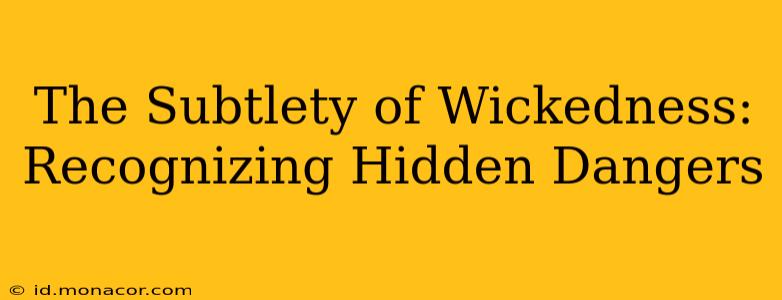Wickedness doesn't always arrive with a flourish of trumpets and a villainous cackle. Often, it slithers in disguised as something benign, something even desirable. Recognizing these hidden dangers requires a keen awareness of human nature and the subtle ways malevolence can manifest. This exploration delves into the insidious nature of wickedness, offering strategies to identify and protect yourself from its subtle forms.
What are some examples of subtle wickedness?
Subtle wickedness manifests in countless ways, often blurring the lines between intentional malice and unintentional harm. Examples include:
-
Passive-aggression: This involves expressing negativity indirectly, through subtle insults, procrastination, or deliberate avoidance. It's a form of emotional manipulation designed to undermine without direct confrontation.
-
Gaslighting: This insidious tactic involves manipulating someone into questioning their own sanity and perception of reality. The abuser subtly twists events and narratives, making the victim doubt themselves and their experiences.
-
Emotional manipulation: This encompasses a broad range of tactics aimed at controlling another person's emotions for personal gain. This can involve guilt-tripping, playing the victim, or using flattery to achieve desired outcomes.
-
Backhanded compliments: These appear positive on the surface but contain a hidden insult or criticism. They're designed to subtly undermine self-esteem and sow seeds of doubt.
-
Undermining someone's reputation: This can involve spreading rumors or gossip, subtly discrediting their achievements, or sabotaging their efforts behind their back.
-
Two-faced behavior: This involves acting differently depending on the audience, often displaying a charming façade to one group while being malicious towards another.
How can you identify subtle wickedness?
Identifying subtle wickedness requires vigilance and self-awareness. Pay attention to:
-
Gut feelings: Trust your intuition. If a situation or interaction feels "off," don't dismiss it.
-
Inconsistencies: Notice discrepancies between words and actions. Does someone's behavior match their claims?
-
Patterns of behavior: Look for recurring instances of manipulative or harmful actions. A single incident might be a mistake, but a pattern suggests a deeper issue.
-
Impact on your well-being: Does interacting with a particular person leave you feeling drained, anxious, or confused? This could be a sign of subtle emotional manipulation.
-
Unrealistic expectations: Be wary of individuals who consistently set unrealistic expectations or demand excessive levels of effort or sacrifice.
-
Changes in others' behavior: Note if people around you seem unusually anxious, withdrawn, or fearful when a particular person is present.
How do you deal with subtle wickedness?
Dealing with subtle wickedness requires a strategic approach:
-
Set boundaries: Clearly communicate your limits and expectations. Don't tolerate behavior that undermines your well-being.
-
Document incidents: Keep records of manipulative or harmful actions. This can be helpful if you need to address the situation with others or seek external support.
-
Seek support: Talk to trusted friends, family members, or a therapist. Sharing your experiences can provide validation and perspective.
-
Limit contact: If possible, reduce your interactions with individuals who engage in subtle wickedness.
-
Prioritize self-care: Focus on activities that promote your emotional and mental well-being. This will help you build resilience and cope with manipulative behaviors.
-
Consider professional help: If you're struggling to cope with subtle wickedness, consider seeking professional guidance from a therapist or counselor.
What are the signs of a manipulative person?
Manipulative individuals often exhibit a combination of the behaviors mentioned above. They might be charming and persuasive on the surface, but their underlying intentions are often self-serving and harmful. Key signs include a tendency to control conversations, disregard others' feelings, and use guilt or shame to get their way.
How can I protect myself from manipulation?
Protecting yourself from manipulation involves building strong self-esteem, setting clear boundaries, and fostering healthy relationships based on mutual respect and trust. Learn to recognize your own vulnerabilities and develop strategies for managing difficult interactions.
Conclusion
Recognizing the subtle forms of wickedness requires awareness, vigilance, and a willingness to confront uncomfortable truths. By understanding the tactics employed by manipulative individuals and developing strategies for self-protection, you can navigate the complexities of human interaction with greater safety and well-being. Remember, your intuition is a powerful tool – trust your gut feeling and prioritize your own mental and emotional health.

